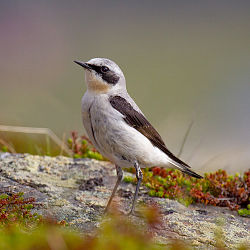Migration
The northern wheatear makes one of the longest journeys of any small bird, crossing ocean, ice, and desert. [12] It migrates from Sub-Saharan Africa in the spring over a vast area of the Northern Hemisphere that includes northern and central Asia, Europe, Greenland, Alaska, and parts of Canada. [12] In autumn all return to Africa, where their ancestors had wintered. [12] Arguably, some of the birds that breed in north Asia could take a shorter route and winter in south Asia; however, their inherited inclination to migrate takes them back to Africa, [12] completing one of the longest migrations for its body size in the animal kingdom. [13]
Birds of the large, bright Greenland race, leucorhoa, make one of the longest transoceanic crossings of any passerine. In spring most migrate along a route (commonly used by waders and waterfowl) from Africa via continental Europe, the British Isles, and Iceland to Greenland. However, autumn sightings from ships suggest that some birds cross the North Atlantic directly from Canada and Greenland to southwest Europe, a distance of up to 2,500 kilometres (1,600 mi). [14] Birds breeding in eastern Canada are thought to fly from Baffin Island and Newfoundland via Greenland, Ireland, and Portugal to the Azores, crossing 3,500 kilometres (2,200 mi) of the North Atlantic) before flying onwards to Africa. [15] Other populations from western Canada and Alaska migrate by flying over much of Eurasia to Africa. [12]
Miniature tracking devices have recently shown that the northern wheatear has one of the longest migratory flights known - 30,000 km (18,640 miles), from sub-Saharan Africa to their Arctic breeding grounds. [16]
"The Alaskan birds travelled almost 15,000km (9,000 miles) each way - crossing Siberia and the Arabian Desert, and travelling, on average, 290km per day. "This is the longest recorded migration for a songbird as far as we know," said Dr Schmaljohann. [16]
Breeding
Northern wheatears first breed when they are one year old. The nest is built entirely by the female while the male perches nearby, sings and sometimes performs song-flights. The nest is placed in a cavity such as a rabbit burrow, a crevice among rocks or in a man-made object such as a wall or pipe. The nest typically has a foundation of untidy plant material. The nest cup is constructed of finer grasses, leaves, moss and lichen. The female lays eggs at daily intervals. The clutch is 4–7 smooth but not glossy eggs that are around 21.0 mm × 15.8 mm (0.83 in × 0.62 in) in size with an average weight of 2.83 g (0.100 oz). The eggs are very pale blue in colour and sometimes have a few red-brown marks at the larger end. They are incubated almost entirely by the female beginning after the penultimate or final egg has been laid. The eggs hatch after approximately 13 days. The chicks are fed by both parents and are brooded by the female for the first five or six days. They fledge after 15 days and become independent of their parents when they are between 28 and 32 days old. Normally only a single brood is raised each year but when a clutch of eggs is lost, the female will lay a second clutch.





